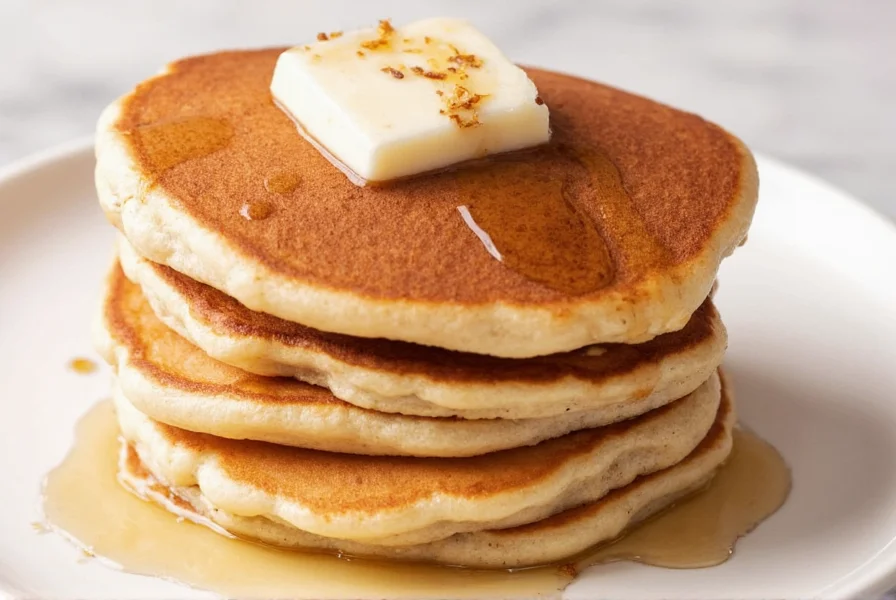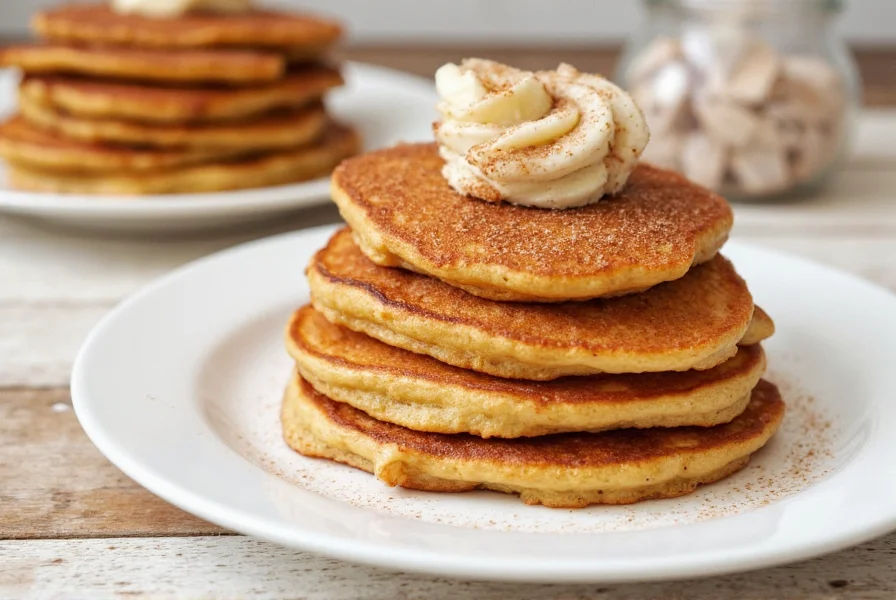There's something magical about the combination of fluffy pancakes and warm cinnamon that transforms a simple breakfast into a comforting experience. Cinnamon pancakes offer that perfect balance of sweet and spice that makes mornings special. Whether you're cooking for family weekend brunch or preparing a special treat for yourself, mastering this recipe elevates your breakfast game significantly.
The Essential Ingredients for Perfect Cinnamon Pancakes
Creating exceptional cinnamon pancakes starts with understanding each component's role. While the basic pancake structure remains consistent, the cinnamon element requires special attention to achieve that perfect aromatic profile without overwhelming bitterness.
All-purpose flour forms the foundation of your batter, providing the necessary structure. For optimal results, measure your flour using the spoon-and-level method rather than scooping directly from the bag, which can lead to dense pancakes. Baking powder and baking soda work together as leavening agents—baking powder for initial rise and baking soda to react with acidic ingredients for extra fluffiness.

The cinnamon selection makes or breaks your recipe. Freshly ground cinnamon from whole sticks delivers superior flavor compared to pre-ground varieties that lose potency over time. Ceylon cinnamon offers a delicate, complex flavor, while Cassia provides that familiar bold punch most associate with cinnamon. For best results in pancakes, use 1½ teaspoons of freshly ground cinnamon per standard recipe serving four people.
Step-by-Step Cinnamon Pancake Recipe
Follow this detailed method for consistently perfect cinnamon pancakes every time. The key is in the mixing technique and temperature control.
| Ingredient | Measurement | Why It Matters |
|---|---|---|
| All-purpose flour | 1½ cups | Provides structure without heaviness |
| Freshly ground cinnamon | 1½ tsp | Optimal spice level without bitterness |
| Buttermilk | 1¼ cups | Creates tender crumb and reacts with baking soda |
| Egg | 1 large | Binds ingredients and adds richness |
| Unsalted butter (melted) | 3 tbsp | Enhances flavor and texture |
- Dry ingredients: Whisk together 1½ cups all-purpose flour, 1½ teaspoons freshly ground cinnamon, 2 teaspoons baking powder, ½ teaspoon baking soda, and ¼ teaspoon salt in a large bowl. Properly incorporating the cinnamon here ensures even distribution without clumping.
- Wet ingredients: In another bowl, beat 1 large egg, then whisk in 1¼ cups buttermilk, 3 tablespoons melted unsalted butter, and 2 tablespoons maple syrup until smooth.
- Combine: Create a well in the dry ingredients and pour in the wet mixture. Gently fold together until just combined—do not overmix. A few small lumps are perfectly fine; overmixing develops gluten and creates tough pancakes.
- Rest: Let the batter rest for 10-15 minutes. This allows the flour to fully hydrate and the leaveners to activate, resulting in lighter pancakes.
- Cook: Heat a griddle or non-stick pan over medium-low heat (325-350°F). Lightly grease with butter or oil. Pour ¼ cup portions of batter onto the cooking surface. Cook until bubbles form on the surface and edges look set (about 2-3 minutes), then flip and cook another 1-2 minutes until golden brown.
Professional Tips for Flawless Cinnamon Pancakes
Achieving pancake perfection requires attention to detail beyond just following the recipe. These professional techniques will elevate your cinnamon pancakes from good to exceptional.
Temperature control is the single most important factor many home cooks overlook. If your cooking surface is too hot, the pancakes will burn on the outside while remaining raw inside. Too cool, and they'll absorb too much oil and become greasy. The ideal temperature allows a drop of water to dance and evaporate within 1-2 seconds.
Batter consistency should resemble thick cream—not runny like milk, nor stiff like cookie dough. If your batter seems too thick after resting, add buttermilk one tablespoon at a time until it reaches the proper consistency. Remember that different flours absorb liquid differently, so adjustments are normal.
Don't press down on pancakes while cooking. This common mistake squeezes out the air bubbles that create lightness, resulting in dense, flat pancakes. Let them cook undisturbed until ready to flip.
Serving Suggestions and Pairings
Cinnamon pancakes shine when paired thoughtfully. While maple syrup is the classic choice, consider these complementary options that enhance rather than overwhelm the delicate cinnamon flavor.
- Fresh fruit compote: Apples or pears simmered with a touch of additional cinnamon create a warm, textured topping that complements the pancakes' spice
- Whipped cream infused with vanilla bean: Adds richness without sweetness overload
- Brown butter syrup: Elevates ordinary maple syrup with nutty complexity that pairs beautifully with cinnamon
- Toasted pecans or walnuts: Provides textural contrast and earthy notes
For beverage pairings, consider coffee with a hint of cinnamon, spiced chai tea, or a simple glass of cold milk. The right drink can enhance the overall flavor experience of your cinnamon pancakes.
Troubleshooting Common Cinnamon Pancake Problems
Even experienced cooks encounter issues with pancakes. Understanding these common problems and their solutions ensures consistent results.
Bitter cinnamon flavor: This typically happens when using too much cinnamon or old, stale spice. Stick to 1-2 teaspoons per standard recipe and use fresh cinnamon. If your spice has been sitting for more than 6 months, replace it.
Dense, rubbery texture: Usually caused by overmixing the batter. Mix wet and dry ingredients until just combined—small lumps are acceptable. Overmixing develops gluten, which creates toughness.
Burning before cooking through: Indicates cooking temperature is too high. Reduce heat and allow the pan to re-stabilize before continuing. A properly heated surface should cook pancakes golden brown in 2-3 minutes per side.
Variations for Different Dietary Needs
Cinnamon pancakes can be adapted for various dietary requirements without sacrificing flavor or texture.
Gluten-free version: Substitute all-purpose flour with a quality gluten-free flour blend designed for baking. Add ½ teaspoon xanthan gum if your blend doesn't include it. The cinnamon flavor actually helps mask any potential aftertaste from gluten-free flours.
Vegan adaptation: Replace buttermilk with plant-based milk plus 1 tablespoon vinegar or lemon juice (let sit 5 minutes to curdle). Use flax egg (1 tablespoon ground flaxseed plus 3 tablespoons water) instead of regular egg, and substitute melted coconut oil for butter.
Lower sugar option: Reduce or eliminate added sugar in the batter—the natural sweetness of maple syrup on top provides sufficient sweetness for most palates. The cinnamon's natural sweetness helps compensate.
Storage and Reheating Techniques
Proper storage ensures your cinnamon pancakes maintain quality if you have leftovers (though they rarely last that long!).
For short-term storage (same day), keep cooked pancakes warm in a 200°F oven on a wire rack set over a baking sheet. This prevents steaming and keeps them crisp at the edges.
For longer storage, cool pancakes completely, then layer between parchment paper in an airtight container. Refrigerate for up to 3 days or freeze for up to 2 months. When reheating, avoid the microwave for best results—instead, use a toaster oven or conventional oven at 350°F for 5-8 minutes until heated through and slightly crisp.
Frequently Asked Questions
Can I use cinnamon extract instead of ground cinnamon in pancakes?
While cinnamon extract delivers intense flavor, it's not recommended as a direct substitute for ground cinnamon in pancakes. Extract is much more concentrated (1 teaspoon extract equals about 3 tablespoons ground cinnamon) and can create an overpowering, artificial taste. For best results, stick with freshly ground cinnamon, which provides balanced flavor and the pleasant texture that extract lacks.
Why do my cinnamon pancakes taste bitter?
Bitterness in cinnamon pancakes usually comes from using too much cinnamon or old, stale spice. Cinnamon contains compounds that become bitter when exposed to air and light over time. Use no more than 1½ teaspoons per standard recipe (serving 4), and replace your cinnamon if it's been sitting for more than 6 months. Freshly grinding cinnamon sticks provides the most balanced flavor without bitterness.
How can I make my cinnamon pancakes fluffier?
For fluffier cinnamon pancakes, ensure your baking powder is fresh (replace every 6 months), don't overmix the batter (small lumps are fine), and let the batter rest for 10-15 minutes before cooking. The resting period allows the flour to fully hydrate and the leaveners to activate. Also, cook at the proper temperature—too hot and the pancakes will burn before rising fully, too cool and they'll absorb too much oil and become dense.
What's the best type of cinnamon for pancakes?
Ceylon cinnamon offers a delicate, complex flavor that works beautifully in pancakes, but Cassia cinnamon (the more common variety) provides that familiar bold punch most people associate with cinnamon. For pancake recipes, Cassia works well due to its stronger flavor that holds up during cooking. However, freshly grinding either variety just before use yields significantly better flavor than pre-ground cinnamon, which loses potency quickly.











 浙公网安备
33010002000092号
浙公网安备
33010002000092号 浙B2-20120091-4
浙B2-20120091-4